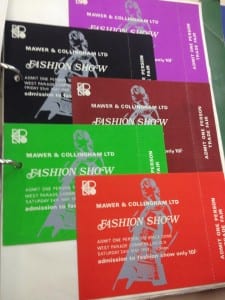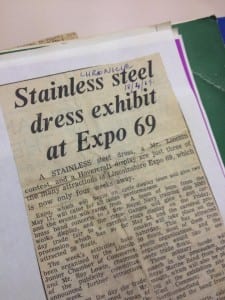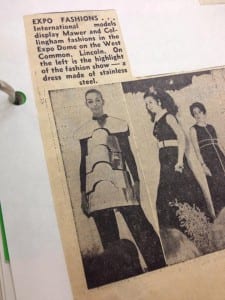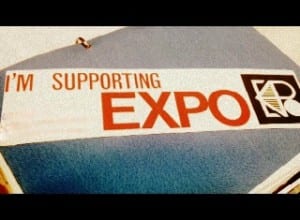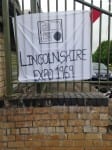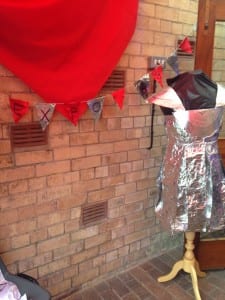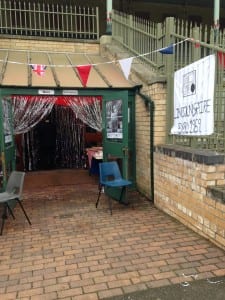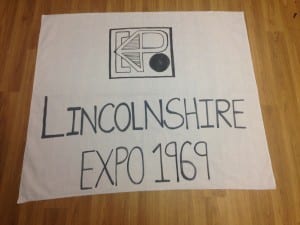Found and Fabricated: A Framing Statement
Within The Grandstand Project, I have been involved in two separate group ideas, both which explore, delve and confront the site’s past life and previous purposes in a variety of ways. Firstly, by focusing on the idea that the Grandstand is longing and waiting a purpose, ‘The Waiting Room’ is a durational performance which exploits the notion of waiting and the passing of time.
This was performed in the ‘Waiting Room’, a room within the Grandstand that is illustrated as this on a blueprint for a proposed mortuary, which also inspired the name of the performance. Influenced by several examples of interactive performance such as Rotozazza’s ‘Ettiquette’, ‘The Waiting Room’ operates on direct audience participation through use of instructions and dialogue, given to audience members in envelopes. The whole piece relies on the audience as partakers rather than observers; each audience member has a purpose. With the room set out as a typical waiting room, each chair has an individual clock and envelope with a specific time to open it which will belong to the audience member who chooses to sit there. In the envelopes, there is either an instruction to follow or a narrative to read out. By gathering responses from our questionnaires, each of these narratives are intertwined with examples of how the specific room was used, what the public are waiting for and what they think the Grandstand is waiting for.
The duration of the piece changed many times but we decided on a interactive fifteen minute piece which is repeated four times every half an hour from 2.15pm to 3.45pm; with the remaining 15 minutes in between performances used to reset for the room. Throughout the performance, we gather materials such as several opened envelopes and their contents to put into a time capsule to later bury. This is to represent the remembrance of the site’s purposes, after years of being on the edge of the map and forgotten.
(Dale, 2014)
In the form of an installation, EXPO ’69 is my second contribution to the overall project. This installation is held in the entrance porch of the Grandstand and re-visits the events of EXPO ’69. This was a week-long festival that took over the Lincolnshire County nearly 45 years ago, with its main event being held in the West Common- which is directly opposite the site of the Grandstand.
By gathering factual information from the Lincolnshire Archives, our aim was to build re-creations of the food, music, colours and events of the original EXPO for audiences to embrace and enjoy throughout the performance afternoon. Our aim was to infuse the past into the present by retrieving back the character and fun to a site where the words ‘abandon’ ‘cold’ and ‘empty’ are presently used to describe it. This event isn’t directly linked to the site but we have connected it by humanising the Grandstand, bringing a lease of life back to the site who would’ve watched over the event as a lonely spectator.
Infusion of the Past and Present: Analysis of Process
The Grandstand emanated coldness and emptiness upon first arrival, however exploring the building’s components I came to realise that the site spoke a thousand words and had a lot more worth and personality than its initial exterior. Our visit to the Lincolnshire Archives was the first step in the process of both pieces, allowing myself to embrace the substance within a site, understanding that site’s like the Grandstand ‘do not have locations, but histories’ (Ingold, 2000, p. 219) to that we can use to construct from.
Before visiting the Archives, our work on site was solely based on presumptions of what we found in and around the site. Roms (2008, p 115) stated that it wasn’t just the location that provides a performance with ‘a sense of identity’ but it is the memories and historic associations that mean a great deal (Pearson, 2010, p. 9) so it was important to us that our research and knowledge gathered in the Archives fully engaged us with the Grandstand’s glory days and ‘the site as a symbol, site as a story-teller’ (Wilkie, 2002, p. 150). Our discovery of blueprints for a proposed mortuary was the first step towards the development of ‘The Waiting Room’.
What I now refer to as the ‘RAF room’, due to the Royal Flying Corps (RFC) insignia mural on the wall was illustrated on these plans as a ‘Waiting Room’.
We presumed this would be where family members would have waited to view their lost loved ones during the wars; we were clarified that this was the case if the mortuary plans succeeded. Additionally, we were informed that the particular room was and still is used as a waiting room for several other reasons, including waiting to test places and giving blood.
Before researching further in the Archives, I was drawn to the particular room as I felt it radiated a lot of character compared to the rest of the site. I think this was the addition of the RFC insignia in the room and also my fascination of the Latin phrases within the insignia. I discovered that ‘Per Ardua ad Astra’ translated as ‘Through adversity to the stars’ which I later discovered is the present RFC motto. This was a part of my discoveries that I wanted to look more into within the process. Taking what we had learnt in the Archives, the concept of recreating the room as a Waiting Room in terms of style, look and atmosphere was our next part in the development process. This took action in our first rehearsal after the Archives visit where we created this style by simply set out the chairs stacked in the room into a box just in front of the fireplace.
There are many aspects of the overall concept that have adapted throughout the process but the style of the room alongside the use of audience participation has been our primary focus continually.
We felt creating a typical waiting room style as audience seating would be a dynamic concept to our piece. This idea will essentially make the audience in the midst of the action, creating a sense of participation rather than observation. We wanted audience members as ‘waiting’ participants in the room but it was important to figure out how to develop an interactive piece that essentially relied on the audience without it risking the quality of the performance and experience. It was further research into the manipulation of human senses within site specific that we looked further into Rotozaza’s Ettiquette. Similar to our concept, Etiquette uses the participants as the entire basis for the performance. The 30 minute ‘experience’ is an example of how auditory given tasks challenge the audience members by exposing ‘human communication at both its rawest and most delicate’ (Rotozaza, 2007) through the use of headphones.
![Etiquette in Buenos Aires, photo Nicolas Goldberg [Available from http://www.rotozaza.co.uk/etiquette2.html]](https://sitespecific2014mpi.blogs.lincoln.ac.uk/files/2014/03/shapeimage_2-300x230.png)
Etiquette in Buenos Aires, photo Nicolas Goldberg
[Available from http://www.rotozaza.co.uk/etiquette2.html]
![Milne, S. [image online] Available at https://sitespecific2014mpi.blogs.lincoln.ac.uk/2014/03/10/talking-sense/](https://sitespecific2014mpi.blogs.lincoln.ac.uk/files/2014/03/image-1-300x225.jpeg)
Milne, S. [image online] Available at https://sitespecific2014mpi.blogs.lincoln.ac.uk/2014/03/10/talking-sense/
The role of the audience has transformed through time as well as through genre, within more contemporary theatre practices such as site specific. Traditionally, the audience are observers, merely watching the action in front of them however ‘audience may find themselves having to participate in other, tangible ways, often acting as an actor ‘substitute’, or even an agent to propel the action forward’ (Tompkins, 2012, pg 10) when experiencing contemporary practice. The function and result of active participants has been debated. Some say that this type of involvement ‘dislocates’ (2012, pg. 10) the audience from the site and therefore the experience; whereas it can also be said to enforce a dynamic experience, providing ‘the opportunity to embody the site’, (2012, pg. 10) In our development, creating a unique experience where the audience are as involved as us is an important factor that we aimed to radiate within our piece; an experience where the audience and we as performers are equal participants.
By Week 7 of performance development and site research, we had organised preparations for set and audience purposes but it was the actual substance and material within the performance that we were struggling to develop. During the early weeks of research, a member of our group, Katherine set up a public questionnaire to gain inspiration to create narratives and dialogue about the site. After showing our progress to tutors and members of the group in the last week of term, we were given a lot of feedback to improve our piece, including more material for participating audiences.
We had already created a few narratives that we read out during the performance but it was later suggested that these narratives (and a lot more) were read out by potential audience members. This would give the audience more purpose as well as a sense of identity within the piece. Using the feedback from the questionnaire as well as information about the site and particular room, we each created several narratives and dialogue for participants to read out…’Whether site-specific performance is interactive or downright confronting, audiences are rarely able to participate passively’ (2012, pg 10). The narratives that were written all link to the several uses of the space including topics such as waiting to give blood, waiting to test planes and waiting to view a dead loved one. A variety of texts to place in envelopes allowed for more extensive symbolic substance which further connected to the site; producing a strong combination of narrative and instruction for audience members to participate in.
The introduction of narrative encouraged the audience’s involvement concept to physically partake and interact with others in the performance as it happens; whether they know it or not, our piece is as interactive (and risky) as it can get. In our final performance, we had a maximum of 8 narratives to use depending how many audience members we had participating and a couple of these were not just written by us but performed as well.
The narrative was created in the form of a list to be read out at end and conclude the 15 minute performances. For example ‘waiting to revive, waiting for salvation, waiting for happiness’.The list was inspired by narratives that we had previously written as well as the performance text of Forced Entertainment’s project ‘First Time’. When pitching this idea, it was suggested to us to make it a lot longer and write it during the performance time to enhance the concept of passing time. Similarly, First Time features a repetitive text, re-using ‘Try not’ in every sentence… ‘Try not to think about anything outside of this room. Anything at all. Try to forget about cars, and meetings, cigarettes, and road accidents’ which continues for a considerable amount of time during the beginning of the piece (Forced Entertainment, 2001). This motivated me to write more to create a longer and more effective text which would link all narratives used and enhance our main focus of time.
A focus on narrative was also evident during the process of developing the EXPO ’69 installation. It was only till near the end of our process however the group felt that the installation was aesthetically appealing but again, it needed more contextual substance. We all agreed on this however it had to be something that we didn’t have to perform but could be seen. A written narrative presented in the room was later created as a way of tackling this issue. By portraying further our idea of humanising the Grandstand, we each wrote an emotive letter from the site that was later combined by Sam so we individually had the opportunity to write.
‘I watch, I’ve always watched. It used to be the case that I enjoyed watching, especially on race day, on race day I came to life. I think it was the chatter of conversation and the swelling of the atmosphere, bounding and echoing between my walls that I enjoyed more than anything. I witnessed the making of many fortunes, as well as the loss of many pay packets. The words of description which seem to encapsulate a race day are those such as excitement, anticipation and emotion, coupled with the likes of disappointment, inadequacy and regret. It’s quiet now, quiet and cold.’
We felt to present this in the installation was a useful and effective component as it would reflect a creative response to the site and event whilst informing audiences of the installations context. Even though these were two separate ideas, the initial idea and development of the EXPO ’69 installation was again, motivated by our visit to the Archives. Although this event isn’t directly connected to the site, the documents in the Archive taught us that EXPO 69 was a carnival like event held on the West Common area (on the fields parallel to the front of the Grandstand). Concerts and fashions shows took place at EXPO with local Lincolnshire businesses such as ‘Curtis’ providing food and drink for the event.
We were extremely intrigued and excited about this discovery as it was different and fun in comparison to the stories of war and death that surrounded the site. This is where the idea of recreating the colourful EXPO event in the form of an installation arose, we all felt that the Grandstand had lost its shine and character; it needed a lease of life.I wanted to replicate specific events of the EXPO as close as we could so we arranged another trip to the Archives to widen our knowledge before we started gathering and hand making materials to create the installation.One of the main events represented was the fashion show, which motivated me to re-produce the original and infamous stainless steel dress.
Within 2 weeks, I created the dress out of cotton and foil which became one of the focal points in our EXPO.
By making the dress as well as other props by scratch, it emanates the production of the original EXPO by reflecting the integrating and juxtaposition of the past and present. Before creating the installation in the main entrance on the Grandstand, I originally wanted to use one of the small storage cupboards in the site. I wanted to construct a condensed representation of the EXPO event which would portray a heightened version of the original components and presumed atmosphere. However when considering the amount of space needed and its specific location within the structure, we found several difficulties and flaws with this idea. The specific cupboard I wanted to use, located at the end of a long corridor was extremely small. This would’ve been completely impractical for audience members to experience as well as the added task of taking out the storage and trying to fit in our materials. It also would have hindered other performances taking places in the same proximity. The decision of changing location close to the performance day concerned me as having the correct measurements for materials to fill the room was extremely important. We looked in and around the site, from bigger cupboards and even outside areas but it was my suggestion of relocating to the entrance porch which spurred our creative processes and designs.
I came to the realisation that this was the ideal place to set the installation as it was parallel to the original EXPO site. The location seamlessly concluded our concept of infusing the past and present as well as introducing the idea of turning our backs on the past; just like the audience would do as they enter the Grandstand.
Pinpointing History: Performance Evaluation
After constantly worrying about ‘The Waiting Room’ and the risks we were taking, it was more successful than we first anticipated. When thinking about the pressure and the unpredictability that could’ve affected the overall quality of the performance, we tackled this and achieved creating a strong interactive experience that emitted themes of tense and time. We were unable to partake in the first scheduled performance due to lack of audience members. Even though we had a back-up plan for every possible outcome, we appreciated this as the second scheduled performance was our strongest due to the having a maximum amount of audience participants involved. It wasn’t a surprise to us that the less audience members there were, the less dynamic and flow the piece had which is what we experienced with 2 other performances, consisting of 3 and 2 audience members. Even with this difficulty, the audience’s interaction with the envelopes worked extremely well for the most part. Some audience members found it difficult to respond to the instructions as well as some narratives being read out late but in general, a nice continuity was achieved with connections intertwined throughout the performances.
Although the combination between narrative and instruction were effective, this type of performance with an undefined outcome created a lot of stress. I was continually worried throughout the day about timings and organisation of correct material as any mistakes would ruin the whole piece. If we were to perform again, I would’ve wanted to allow more time to reset the room; the 15 minute set time manifested a tense and panicked atmosphere which slightly affected my personal concentration during the beginning of the performances. ‘Site may be directly suggestive of a subject-matter, theme, dramatic structure’ and by taking historical purposes of the building, I believe we achieved producing an interactive performance which fully connected to the site. In relation to the EXPO ’69, I definitely feel we achieved in giving the site a lease of life. The use of colour and set up that we created allowed each audience member to absorb the hidden character and potential of the building.
The combination of the dress being presented with the food and music was inviting whilst context within the narrative encouraged the audience to understand and interact with the installation.I didn’t anticipate how long it would take to set up the room initially so if I could go back, I would allow for more time to perfect the overall aesthetic of the room.
Although seeing people enjoy the handmade decorations that we had made and presented was extremely satisfying, I felt it could’ve looked a lot more professional if we had been more organised and aware of the time. Before engaging with this module, I didn’t fully understand or appreciate contemporary practice of this kind as I preferred the comforts of a traditional theatre. I was reluctant as I didn’t find non-traditional venue performance particularly appealing however I began to enjoy the difference in working in a space that contributes creatively to and within a performance. The combination of applying the ‘factual with the fictional, event with imagination, history with story, narrative with fragment, past with present’ (Heddon, 2008, p.9) within the module was intriguing and inspiring. Although the module was difficult, it allowed me to look past first impressions and explore the potentials of theatre within non-traditional settings.
Word Count: 3,011
Bibliography
Copely, K (2014) Pictures taken on site [Accessed 16 May 2014]
Dale, A (2014) ‘The Waiting Room’ Time Capsule (Post Performance) [online video] Available from : https://www.youtube.com/watch?v=qHRYiH8IqM8 [Accessed 16 May 2014]
Davies, K (2014) Pictures taken at the Lincolnshire Archives [Accessed 16 May 2014]
Forced Entertainment (2001) First Time. [online] Forced Entertainment Ltd. Available from http://www.forcedentertainment.com/page/144/First-Night/92 [Accessed 11 May 2014]
Heddon, D (2008) Autobiography and Performance. Basingstoke: Palgrave Macmillian
Ingold, T (2000) The Perception of the Environment: Essays on Livelihood, Dwelling and Skill. London: Rouledge
Kaye, N. (2000). Site-Specific Art. 1st ed. London: Routledge.
Milne, S (2014) The Grandstand Project- Site Specific Module Blog. [multiple blog entries] 3 Feb 2014- 7 May 2014. Available from: https://sitespecific2014mpi.blogs.lincoln.ac.uk/
Roms, H. (2008) Staging an Urban Nation. In: Holdsworth, N. and Luckhurt, M. (ed) Contemporary British and Irish Drama. Oxford: Blackwell.
Rotozaza (2007) Etiquette- Rotozaza’s Micro/Autoteatro Work, Online: http://www.rotozaza.co.uk/etiquette2.html [Accessed 10 May 2014]
Pearson, M (2010) Site Specific Performance. New York: Palgrave Macmillian.
Tompkins, Joanne (2012) The ‘Place’ and Practice of Site Specific Theatre and Performance. [online] London: Palgrave Macmillian. Available from http://www.palgrave.com/PDFs/9780230364066.pdf [Accessed 9 April 2014]
Wilkie, F. (2002) Mapping the Terrain: a Survey of Site-specific Performance in Britain. New Theatre Quarterly. 18 (2) 150.

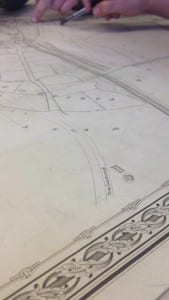
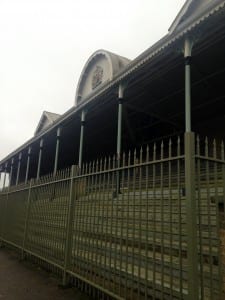
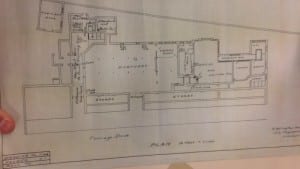
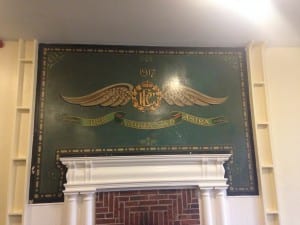
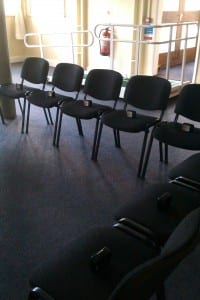

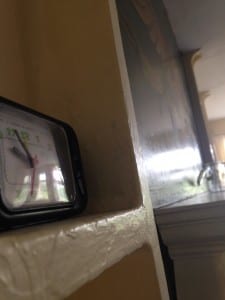
![Dale, A (2014) Newspaper extract of EXPO. Taken 13 February 2014 [Accessed 16 May 2014]](https://sitespecific2014mpi.blogs.lincoln.ac.uk/files/2014/03/a75f1a3a-6fad-4a2d-bc0a-ccc253c267ed-300x225.jpg)
